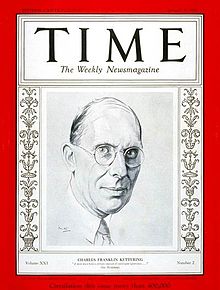Kettering lived in Dayton, Ohio, and I have seen him on a number of occasions. Our next door neighbor, who was a GM plant manager, later on, head of Truck and Bus, and then Cadillac, had some joint patents with him. Another neighbor, a Doctor, was his family physician. GM gave Kettering a new Cadillac each year, he drove around in a Chevy, which he bought, the story goes.

Charles Franklin Kettering, the American engineer and longtime director of research for General Motors Corp. (GM), is born on August 29, 1876, in Loudonville, Ohio. Of the 140 patents Kettering obtained over the course of his lifetime, perhaps the most notable was his electric self-starter for the automobile, patented in 1915.
Early in his career, Kettering worked at the National Cash Register Company in Dayton, Ohio, where he helped develop the first cash register to be equipped with an electric motor that opened the register drawer. With Edward A. Deeds, he formed Dayton Engineering Laboratories Company (DELCO), a business dedicated to designing equipment for automobiles. Kettering's key-operated electric self-starting ignition system, introduced on Cadillac vehicles in 1912 and patented three years later, made automobiles far easier and safer to operate than they had been previously, when the ignition process had been powered by iron hand cranks. By the 1920's electric self-starters would come standard on nearly every new automobile.
United Motors Corporation (which later became General Motors) purchased DELCO in 1916, installing Kettering as vice president and director of research at GM from 1920 to 1947. During his tenure at GM, Kettering was instrumental in the development of improved engines, quick-drying automobile paints and finishes, "anti-knock" fuels (designed to reduce the damaging process of engine knocking, which occurs when gasoline ignites too early in an internal combustion engine) and variable-speed transmissions, among other innovations.

